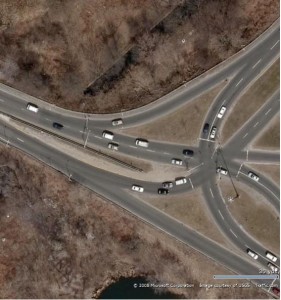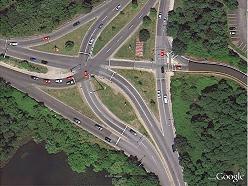
Note: This post is an update of a post including the meeting notice. I’ve edited that post rather than creating a new post so as to keep the comments together.
At a meeting held last night, the Massachusetts Highway Department presented its plans and took input for a redesign of the Route 2/16 Intersection. In most respects the proposal was positively received, although those attending raised a number of issues meriting further consideration by the designers.
This project comes out of planning meetings which Senator Tolman initiated and which I participated in over the past few years. These meetings built on Alewife traffic studies going further back led by the state’s Central Transportation Planning Staff.
Here are the highlights of the proposal:
- Changing the intersection geometry by shaving the traffic islands in the middle and by converting a short “sidewalk to nowhere” segment along the intersection to pavement
- to add another lane of storage for cars turning on to Rt 16 East from Rt 2 East
- to add a second lane for cars turning from Rt 16 West to Rt West
- to add a lane so that cars leaving the jug handle ramp coming up from the T station don’t have to merge immediately — make the departure of Route 2 West from the intersection have 3 lanes, coming back to 2 lanes as it goes under the pedestrian bridge
- Change the signal from a four phase model to a three phase model — saving yellow and stop times.
- Put the signal timing up and down Alewife Brook Parkway on GPS based signal timing so that it will remain in phase — in practice, it is often out of phase, using old timing technology.
The project is three to five years away from construction. This meeting was a “25% design” meeting — there is a lot of design work to complete and then the question of funding. It’s perceived as a cost-effective project — at roughly 2 million, it offers significant safety and throughput benefits.
From the original notice — 10 days to submit written comments:
Written statements and other exhibits in place of, or in addition to, oral statements made at the Public Hearing regarding the proposed undertaking are to be submitted to Thomas F. Broderick, P.E., Acting Chief Engineer, MassDOT, 10 Park Plaza, Boston, MA 02116, ATTN: Project Management Section, Project File No. 605637. Such submissions will also be accepted at the hearing. Mailed statements and exhibits intended for inclusion in the public hearing transcript must be postmarked within ten (10) business days of this Public Hearing. Project inquiries may be emailed to dot.feedback.highway@state.ma.us


This will never happen BUT they should bag the current configuration and go back to the traffic circle of old. Once the public was educated about traffic circle rules, who has the right of way, the traffic circle is the most efficient way to move traffic through a congested intersection, avoids the idling and pollution of vehicles waiting at a light, and keeps most of the cars moving most of the time. There is plenty of space for a redesigned roundabout and it would be the cheapest solution in the end.
For what it is worth, this option was explicitly reviewed in the most recent studies. In a rotary design, the concern was that traffic would not be able to enter from the T jug handle ramp.
I believe there was a 2009 study and evaluations of four to six improvements. The most effective ones were a traffic circle and intersection with fly-overs. The traffic circle, however did need slip lanes (short-cuts for right turners). Without them, Rep. Brownsberger would be correct.
Unfortunately, improving the intersection to flow well has two repercussions, pan handlers can no longer solicit waiting motorists ;), and the pair of traffic lights at Alewife Brook Park and Rindge Ave. will block traffic back into the rotary, gridlocking all flows – there just isn’t enough storage (parking) space between the intersection and those lights. Rather than look at solving the bottleneck with the traffic lights, engineers endorsed changes that brought limited improvement and lower cost. Besides Cambridge and the DCR (MDC) wants to keep the parkways at 1930’s capacity, even getting them listed as national historic places to block modernization.
This is a horribly designed intersection, and needs considerable work. The congestion here encourages people to cut through residential streets, and a good fix will make life better for people in surrounding neighborhoods.
There should be a real effort to fix the backups for people trying to leave the area and escape onto Route 2 west. The merge with the exit from the Alewife station is an easy fix. Better traffic signal timing would also be a tremendous help.
It would also be great to find a way to expedite MBTA buses moving in and out of Alewife. Why sit in traffic if the bus can get you home faster?
“A Modest Proposal” or “When Circles Attack”
http://en.wikipedia.org/wiki/Magic_Roundabout_(Swindon)
The official name of the roundabout used to be County Islands, but it was changed in the late 1980s to match its popular name – the Magic ROundabout. It inspired the song “English Roundabout”, a pop song by the Swindon band XTC, which was recorded for their 1982 album English Settlement.
In 2005, it was voted the worst roundabout in a survey by a UK insurance company.[4] In September 2007, the Magic Roundabout was named as one of the World’s Worst Junctions by a UK motoring magazine.[5] In December 2007, BBC News reported a survey identifying The Magic Roundabout as one of the “10 Scariest Junctions in the United Kingdom”.[6] However the roundabout provides a better throughput of traffic than other designs and has an excellent safety record, since traffic moves too slowly to do serious damage in the event of a collision.[7] It is considered one of the 7 urban wonders of the world in the city roads and streets category.[8]
In December 2008, a Christmas tree was added to the centre of the roundabout.[9]
In February 2009 artist/filmmaker Tom White completed the short experimental film, Swindon Roundabouts. The film consists of long hypnotic shots of the roundabout and its surrounding area collaged with interviews of local residents and an unsettling soundtrack. The film is intended as a homage to the late Frank Blackmore, inventor of the mini-roundabout.[10] The film can be seen at the Swindon viewpoint online archive.
The problem with this intersection is that it’s actually four intersections. I wrote about it in the July 2009 Belmont Citizens Forum Newsletter, http://www.belmontcitizensforum.org/newsletters/2009/BCFJul09.pdf .
You can see the overhead map from the CTPS study of bus access to Alewife there.
Meg,
Thank you. This is useful link for people to have.
Thanks, all for commenting! It will be an interesting hearing.
I’ll be there tonight!
The only ones who benefited from going from a rotary to an intersection were the panhandlers!
First, my concerns: Congestion on Fresh Pond Parkway puts more traffic on Mass Ave in Cambridge, slowing MBTA bus service there through Arlington.
Second, combined with congestion on Alewife Brook Parkway (Rt. 16), traffic diverts through Arlington and West Medford center (rt 60), both past schools.
Third, there seems to be a large amount of traffic flow between I-93 and Rt. 2, yet Rt 16 was narrowed from four to two lanes near I-93 about 30 years ago, can that be undone?
Forth, the MDC made all the local parkways national historic sites in 2004/2005. How are improvements now possible?
What is the area history? Alewife station and the rotary got replaced around 1985(?). Rt 2 widening finished about 1971(?). The pedestrian bridge to nowhere (Lanes ‘n Games) got built in 1973(?). Rt 16 got narrowed at Rt. 38 in the late 70’s? When were traffic lights added for Rindge Ave. and Alewife Brook Park?
In what year(s) were Alewife Brook, Fresh Pond, and Mystic Valley Parkways made their current four lane (mostly) widths? A hundred years ago?
Given that Rt 2 was widened already 40 years ago and the other major arteries not, is there any surprise that bright, young people graduating from our colleges and Universities go to live/work elsewhere? Our population and economic vitality are stagnant while less congested and gridlocked places grow.
We are as livable and sustainable as a root bound house plant constrained in a small pot.
BTW, Cambridge’s attitude has been opposed to congestion relief – they think its not their problem, its the MBTA’s problem for not expanding mass transit further out. Traffic flows show that won’t help.
Thanks for coming last night, Mark. You made a number of helpful suggestions.
You are quite right that the traffic congestion in the area reflects a history of changing plans — first a highway, then a subway extension both only half built.
I was pleased to read about the new traffic plan for the Alewife/Rt2/Rt16 intersection. The delayed traffic light timing, going east, at Rindge Ave is definitely a challenge for Rt. 16 traffic trying to proceed through the green light at the Rt 2 merge. The other issue is that Rt 2 drivers at that merge continue through the light, even when red, blocking the Rt 16 drivers. The 350 & 79 buses to Alewife can take up to 3 to 4 light cycles (20 minutes) to get through that area to the Alewife station. The Rt 2 merge green light is much too long compared to the Rt 16 green light compounding backup, as I mentioned before, by the delayed light at Rt2 and Rindge Ave.
Would it be a consideration to move or place a stoplight on Rt 2 well before the merge?
An additional light is not an option that was raised during the study process. My instinct is that it could only make things worse — how do you see it helping?